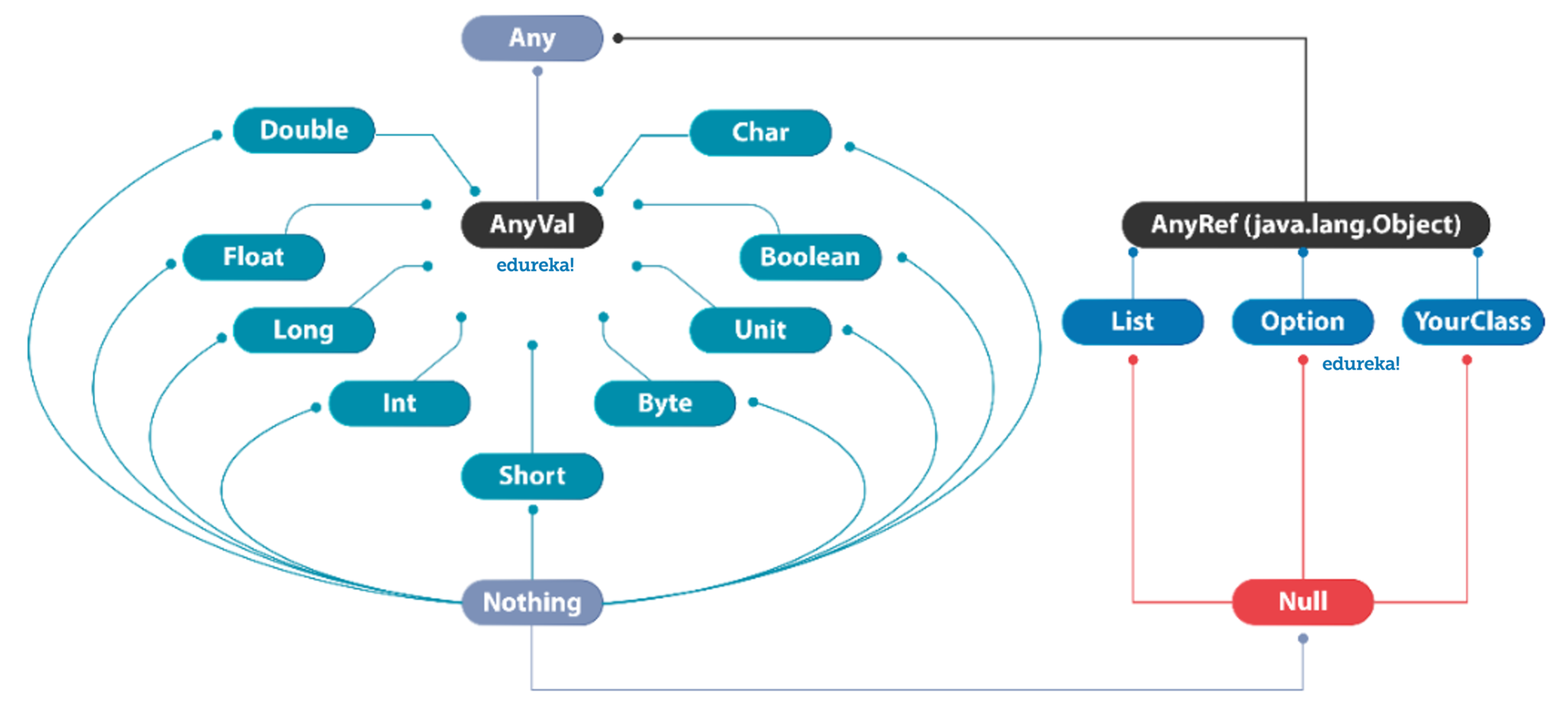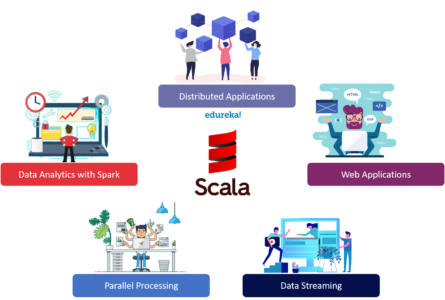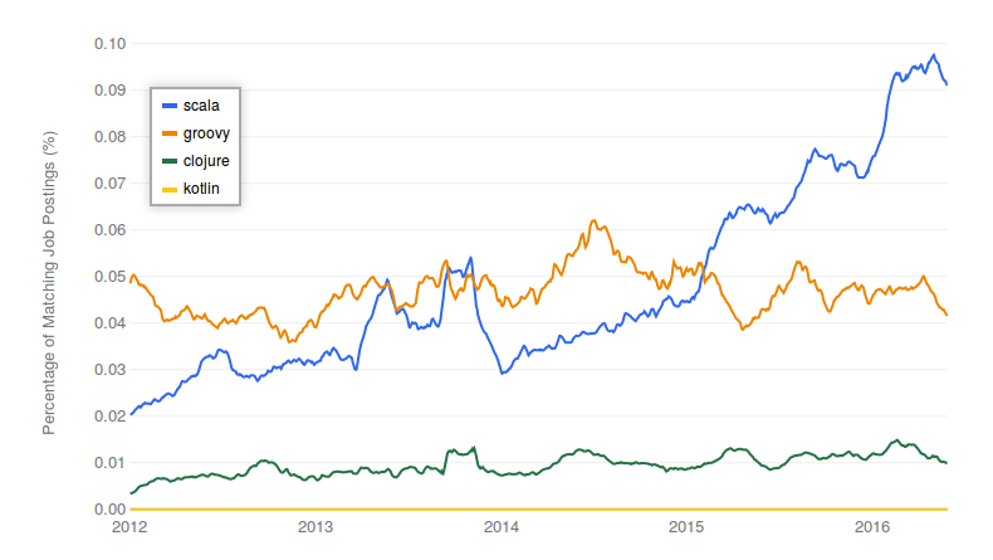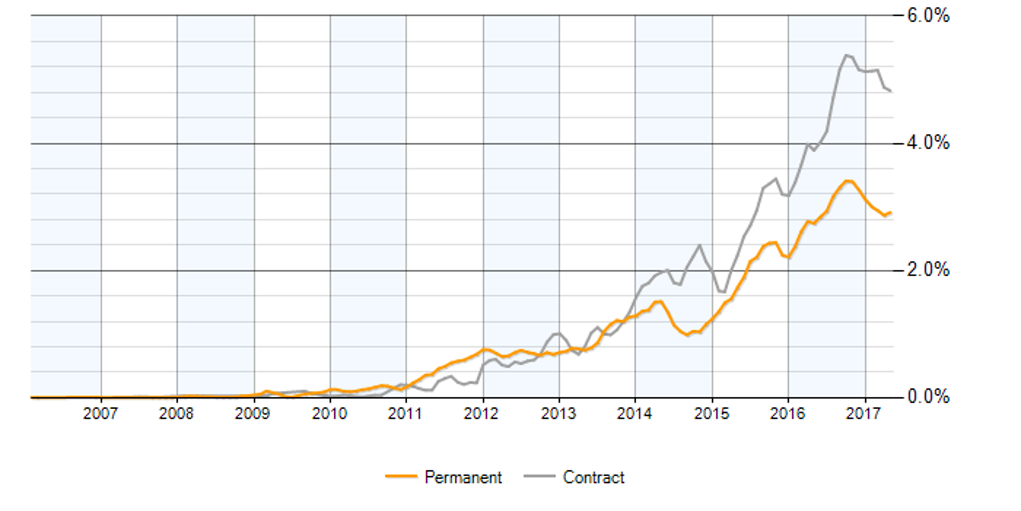Microsoft Azure Data Engineering Training Cou ...
- 16k Enrolled Learners
- Weekend/Weekday
- Live Class
What is Scala? A Robust and High-Caliber programming language that changed the world of big data. Scala is capable enough to outrun the speed of the fastest existing programming languages. I’ll walk you through this What is Scala article so that you can understand the true capabilities of Scala.
I’ll line up the docket for this as below.
So, let us begin with our first question.
Well, Scala is a programming language invented by Mr. Martin Odersky and his research team in the year 2003.
Scala is a compiler based and a multi-paradigm programming language which is compact, fast and efficient. The major advantage of Scala is the JVM (Java Virtual Machine). Scala code is first compiled by a Scala compiler and the byte code for the same is generated, which will be then transferred to the Java Virtual Machine to generate the output.
Thus, the Scala became the key to success for managing the huge amount of big-data.
Now that we know the importance of Scala, let us now understand why actually it is the most preferred language in the present trends.

Now that we have understood the requirements for which we needed Scala. Let us move into the comparison between the other languages and find out why it gets an edge over the other similar programming languages.
The Name Scala portraits the scalability the language is capable of offering, now you might raise a question. Aren’t the latest programming Languages like Python, Ruby, Perl and the Legendary Java not scalable?

The answer is yes, they are scalable, but with some restrictions like the boiler plated codes like system.print.ln in Java. Scala is invented to overcome these limitations and minimize the execution time and complexity of the code.
In the year 2006 Twitter was introduced in America and the developers used ruby on rails as their weapon of choice to develop this application, which later proved out to be a wrong choice when they had to manage the gigantic amount Big-Data which was dropping into the Twitter.
 Then they switched their backend to Java and used Scala as their new programming language to handle the big data using Hadoop and Spark frameworks which worked in a spectacular way. You can get a better understanding with the Microsoft Azure Data Engineer Course.
Then they switched their backend to Java and used Scala as their new programming language to handle the big data using Hadoop and Spark frameworks which worked in a spectacular way. You can get a better understanding with the Microsoft Azure Data Engineer Course.

Now we know the capabilities of Scala, Let us now understand its powerful features:
Scala is both a functional Programming Language and an object-oriented programming Language. Every variable and value which is used in Scala is implicitly saved as an object by default.
Scala can support multiple language constructs without the need of any Domain Specific Language (DSL)Extensions, Libraries, and APIs.

Scala binds the Datatype to the variable in its entire scope.
Scala provides a lightweight syntax for defining functions, it supports higher-order functions, it allows functions to be nested.
Scala compiles the code using scala compiler and converts code into Java Byte Code and Executes it on JVM.
The best way to become a Data Engineer is by getting the Azure Data Engineering Course in Atlanta.
These were the Features of Scala and let us get into few of the frameworks of Scala is capable to support.

Akka, Spark, Play, Neo4j, Scalding are some of the major frameworks that Scala can support.
These were the popular Frameworks supported by Scala, Now let us understand the variables and data types in Scala.
Variables can be defined as the reserved memory locations used to store the values. Similarly, we do have variables in Scala Programming Language as well. The Variables in Scala are divided into two types.

Mutable Variables
These variables allow us to change a value after the declaration of a variable. Mutable variables are defined by using the var keyword. The first letter of data type should be in capital letter because in Scala data type is treated as an object.
var b = "Edureka" b = "Brain4ce Organisation"
output:
b: String = Edureka
b: String = Brain4ce Organisation
In this case, the variable will accept the new string and displays it.
Immutable Variable
These variables do not allow you to change a value after the declaration of a variable. Immutable variables are defined by using the val keyword. The first letter of data type should be in capital letter because in the Scala data type is treated as objects.
val a = "hello world" a = "how are you"
output:
a: String = hello world
<console>:25: error: reassignment to val
a = “how are you”
^

This code will give an error and the new value will not be accepted by the variable a.
lazy val x = 100 x*2
output:
x: Int = <lazy>
res: Int = 200
Lazy Evaluation is the primary feature of Scala which bought it the dignity of a whole new level. Here, the declared variable will not be accessed or any operation is not performed on to the variable unless the programmer particularly accesses it and performs an operation on to it.
In simple words, it is an On-Demand execution of an operation which saves a lot of memory and processing resources in real-time.
Redefine your data analytics workflow and unleash the true potential of big data with Pyspark Course.

An array is a data structure which stores a fixed-size sequential collection of elements of the same data type.
We shall look into a few examples of arrays in Scala
val array = new Array[Int](10)
output:
array: Array[Int] = Array(0, 0, 0, 0, 0, 0, 0, 0, 0, 0)
array(0) = 10 array(1) = 2
output:
array: Array[Int] = Array(0, 0, 0, 0, 0, 0, 0, 0, 0, 0)
res: Array[Int] = Array(10, 2, 0, 0, 0, 0, 0, 0, 0, 0)
val mystring = Array("Edureka", "Brain4ce", "Organisation")
for ( x <- mystring )
{
println( x )
}
output:
Edureka
Brain4ce
Organisation
import scala.collection.mutable.ArrayBuffer
output:
import scala.collection.mutable.ArrayBuffer
val a = ArrayBuffer[Int]()
output:
a: scala.collection.mutable.ArrayBuffer[Int] = ArrayBuffer()
a += 1
output:
res: a.type = ArrayBuffer(1)
a += (2,3,4,5)
output:
res: a.type = ArrayBuffer(1, 2, 3, 4, 5)
a ++= Array(6, 7, 8)
output:
res: a.type = ArrayBuffer(1, 2, 3, 4, 5, 6, 7, 8)
a.trimEnd(2)
output:
res: a.type = ArrayBuffer(1, 2, 3, 4, 5, 6, 7, 8)
res: scala.collection.mutable.ArrayBuffer[Int] = ArrayBuffer(1, 2, 3, 4, 5, 6)
a.insert(2, 9)
output:
res: scala.collection.mutable.ArrayBuffer[Int] = ArrayBuffer(1, 2, 3, 4, 5, 6)
res: scala.collection.mutable.ArrayBuffer[Int] = ArrayBuffer(1, 2, 9, 3, 4, 5, 6)
a.insert(2,0,9,6,1)
output:
res: scala.collection.mutable.ArrayBuffer[Int] = ArrayBuffer(1, 2, 9, 3, 4, 5, 6)
res: scala.collection.mutable.ArrayBuffer[Int] = ArrayBuffer(1, 2, 0, 9, 6, 1, 9, 3, 4, 5, 6)
This function is used to remove an element in the second memory location of the Array Buffer.
a.remove(2)
output:
res: scala.collection.mutable.ArrayBuffer[Int] = ArrayBuffer(1, 2, 0, 9, 6, 1, 9, 3, 4, 5, 6)
res: Int = 0
res: scala.collection.mutable.ArrayBuffer[Int] = ArrayBuffer(1, 2, 9, 6, 1, 9, 3, 4, 5, 6)
a.remove(2, 3)
output:
res: scala.collection.mutable.ArrayBuffer[Int] = ArrayBuffer(1, 2, 9, 6, 1, 9, 3, 4, 5, 6)
res: scala.collection.mutable.ArrayBuffer[Int] = ArrayBuffer(1, 2, 9, 3, 4, 5, 6)
Array(1,2,3,4).sum
output:
res: Int = 10
Array(1,2,3,4).max
output:
res: Int = 4
val a = Array(1,5,3,2,4) scala.util.Sorting.quickSort(a)
output:
a: Array[Int] = Array(1, 5, 3, 2, 4)
res: Array[Int] = Array(1, 2, 3, 4, 5)
The Scala List is an immutable sequence of elements, implemented as a linked list. Unlike an array, a linked list consists of many small objects, each containing a reference to an object as well as a reference to the rest of the list
Now we shall look into few examples of lists in Scala.
val list = 1 :: 2 :: 3 :: Nil val list = List(1,2,3)
output:
list: List[Int] = List(1, 2, 3)
list: List[Int] = List(1, 2, 3)
val x = List(2) val y = 1 :: x val z = 0 :: y
output:
x: List[Int] = List(2)
y: List[Int] = List(1, 2)
z: List[Int] = List(0, 1, 2)
val originalList = List(5, 1, 4, 3, 2) val newList = originalList.filter(_ > 2)
output:
originalList: List[Int] = List(5, 1, 4, 3, 2)
newList: List[Int] = List(5, 4, 3)
import scala.collection.mutable.ListBuffer
output:
import scala.collection.mutable.ListBuffer
val x = ListBuffer(1, 2, 3, 4, 5, 6, 7, 8, 9)
output:
x: scala.collection.mutable.ListBuffer[Int] = ListBuffer(1, 2, 3, 4, 5, 6, 7, 8, 9)
x -= 5
output:
res: x.type = ListBuffer(1, 2, 3, 4, 6, 7, 8, 9)
x.remove(0)
output:
res: Int = 1
res: scala.collection.mutable.ListBuffer[Int] = ListBuffer(2, 3, 4, 6, 7, 8, 9)
val x = List.range(1,10)
output:
x: List[Int] = List(1, 2, 3, 4, 5, 6, 7, 8, 9)
val x = List.range(0,10,2)
output:
x: List[Int] = List(0, 2, 4, 6, 8)
val x = List.fill(3)("Apple")
output:
x: List[String] = List(Apple, Apple, Apple)
val x = List.tabulate(5)(n = n + n)
output:
x: List[Int] = List(0, 2, 4, 6, 8)
val x = List(1,2,3)
output:
x: List[Int] = List(1, 2, 3)
val y = 0 :: x
output:
y: List[Int] = List(0, 1, 2, 3)
val a = List(1,2,3) val b = List(4,5,6) val c = a ::: b
output:
y: List[Int] = List(0, 1, 2, 3)
a: List[Int] = List(1, 2, 3)
b: List[Int] = List(4, 5, 6)
c: List[Int] = List(1, 2, 3, 4, 5, 6)
val c = List.concat(a, b)
output:
c: List[Int] = List(1, 2, 3, 4, 5, 6)
val x = List(1,2,3)
x.foreach { println }
output:
x: List[Int] = List(1, 2, 3)
1
2
3
var flowers = new ListBuffer[String]() flowers += "Rose" flowers += "Lilly" flowers += "Tulip"
output:
flowers: scala.collection.mutable.ListBuffer[String] = ListBuffer()
res: scala.collection.mutable.ListBuffer[String] = ListBuffer(Rose)
res: scala.collection.mutable.ListBuffer[String] = ListBuffer(Rose, Lilly)
flowers += ("Daisy", "Sunflower", "Jasmine")
output:
res: scala.collection.mutable.ListBuffer[String] = ListBuffer(Rose, Lilly, Tulip, Daisy, Sunflower, Jasmine)
flowers -= "Rose"
output:
res: scala.collection.mutable.ListBuffer[String] = ListBuffer(Lilly, Tulip, Daisy, Sunflower, Jasmine)
flowers -= ("Lilly", "Tulip")
output:
res: scala.collection.mutable.ListBuffer[String] = ListBuffer(Daisy, Sunflower, Jasmine)
flowers --= Seq("Daisy", "Sunflower")
output:
res: scala.collection.mutable.ListBuffer[String] = ListBuffer(Jasmine)
val flowersList = flowers.toList
output:
flowersList: List[String] = List(Jasmine)
A Set is a collection that contains no duplicate elements. By default, Scala uses the immutable Set. If you want to use the mutable Set, you’ll have to import the library called,
import scala.collection.mutable.Set class explicitly.
We shall try out some examples of sets in Scala.
var s : Set[Int] = Set() var s : Set[Int] = Set(1,1,5,5,7)
output:
var s : Set[Int] = Set()
var s : Set[Int] = Set(1,1,5,5,7)
var s = Set(1,3,5,7)
output:
s: scala.collection.immutable.Set[Int] = Set(1, 3, 5, 7)
val fruit = Set("apples", "oranges", "pears")
println( "Head of fruit : " + fruit.head )
println( "Tail of fruit : " + fruit.tail )
println( "Check if fruit is empty : " + fruit.isEmpty )
val nums: Set[Int] = Set()
println( "Check if nums is empty : " + nums.isEmpty )
output:
fruit: scala.collection.immutable.Set[String] = Set(apples, oranges, pears)
Head of fruit : apples
Tail of fruit : Set(oranges, pears)
Check if fruit is empty : false
nums: Set[Int] = Set()
Check if nums is empty : true
val fruit1 = Set("apples", "oranges", "pears")
val fruit2 = Set("mangoes", "banana", "oranges")
val fruit = fruit1 ++ fruit2
fruit
output:
fruit1: scala.collection.immutable.Set[String] = Set(apples, oranges, pears)
fruit2: scala.collection.immutable.Set[String] = Set(mangoes, banana, oranges)
fruit: scala.collection.immutable.Set[String] = Set(banana, apples, mangoes, pears, oranges)
var set = scala.collection.mutable.Set[Int]()
output:
set: scala.collection.mutable.Set[Int] = Set()
set += 1
output:
res: scala.collection.mutable.Set[Int] = Set(1)
set += (2, 3) set.add(6) set.add(2)
output:
res: scala.collection.mutable.Set[Int] = Set(1, 2, 3)
res: Boolean = true
res: Boolean = false
A Scala Map is a collection of a Key-value pair. A map cannot have duplicate keys, but different keys can have the same values
We shall try a few examples of maps in Scala.
val colors1 = Map("red" -> "#FF0000", "azure" -> "#F0FFFF", "peru" -> "#CD853F")
val colors2 = Map("blue" -> "#0033FF", "yellow" -> "#FFFF00", "red" -> "#FF0000")
colors1.keys
colors1.values
colors1.isEmpty
var colors = colors1 ++ colors2
output:
res: Iterable[String] = Set(red, azure, peru)
res: Iterable[String] = MapLike(#FF0000, #F0FFFF, #CD853F)
res: Boolean = false
Let us check another example in maps.
val mapping = Map("virat" -> "kohili", "mahendra" -> "singhdhoni")
val mapping = scala.collection.mutable.Map("virat" -> "kohili", "mahendra" -> "singhdhoni")
mapping("virat")
mapping -= "mahendra"
mapping += ("ajay"-> "sharma")
mapping.getOrElse("virat", 0)
output:
mapping: scala.collection.immutable.Map[String,String] = Map(virat -> kohili, mahendra -> singhdhoni)
mapping: scala.collection.mutable.Map[String,String] = Map(mahendra -> singhdhoni, virat -> kohili)
res: String = kohili
res: mapping.type = Map(virat -> kohili)
res: mapping.type = Map(virat -> kohili, ajay -> sharma)
res: Any = kohili
Scala tuple combines a fixed number of items together so that they can be passed around. Unlike an array or list, a tuple can hold objects with different types, but they are also immutable. The following is an example of a tuple holding an integer, a string.
We shall try a few examples of tuples in Scala.
val a = (1,2,"Ajay","Devgan") a._1 a._3
output:
a: (Int, Int, String, String) = (1,2,Ajay,Devgan)
res: Int = 1
res: String = Ajay
These were the Collections supported by Scala, Now let us understand the Control Statements.
Now with this, we shall move into our next topic, the control statements.

An if statement decides to execute which of the two given statements.
for (i <- 0 to 5; j <- 0 to 5 if i==j) println(i + j)
output:
0
2
4
6
8
10
An if statement which will be followed by an else statement which executes one of the two statements. if the condition provided at the if block is true then the if block statements will be executed. else, the statements at the else block will be executed.
var x = 5 val s = if (x > 0 && x < 6) 1 else 0 val s =if (x > 0 && x < 6) "positive" else 0
output:
x: Int = 5
s: Int = 1
s: Any = positive
While is a control statement which checks the condition and determines whether to execute a particular set of statements present in the loop or not.
var args = "Edureka"
println("length is " + args.length)
var i = 0
while(i < args.length)
{
println(args(i))
i+= 1
}
output:
E
d
u
r
e
k
a
Do While loop is similar to While loop with the only difference which is the condition to the loop lies at the end of the loop program block as shown below. The Do while loop executes at least for once as the condition checked after the execution of statements in the block.
var x=7
do
{
println(x)
x=x-1
}while(x > 0);
output:
7
6
5
4
3
2
1
For loop is a simple loop which has an initializing variable, counter variable and a condition in it. The initializing variable will be initialized to a certain value and counter variable counts the iterations and the iterations will run until the provided condition is true.
for ( i <- 1 to 5) println(i) #Advaned For Loop for (i <- 0 to 5 if i==j) println(10*i + j)
output:
1
2
3
4
5
output (Advanced For Loop):
0
11
22
33
44
55
For each iteration of your for loop, yield generates a value which will be remembered.
It’s like the for loop has a buffer you can’t see, and for each iteration of your for loop, another item is added to that buffer. When your for loop finishes running,
it will return this collection of all the yielded values.
for (i <- 1 to 5) yield i for (i <- 1 to 5) yield i * 2
output:
res: scala.collection.immutable.IndexedSeq[Int] = Vector(1, 2, 3, 4, 5)
res: scala.collection.immutable.IndexedSeq[Int] = Vector(2, 4, 6, 8, 10)
Foreach control statement is similar to the for loop on the only difference is it prints each value and to iterate items in a list, we can use for loop. It operates on arrays or collections such as ArrayList, which can be found in the System.
var args= "Hello" args.foreach(println(arg))
output:
H
e
l
l
o
def area (radius: Int): Double= {
println("This is a function to perfrom double operations")
3.14 * radius * radius
}
area(radius)
output:
res: Double = 1384.74
Now Let us understand the Applications where we require Scala.
Scala is a powerful programming language that has the capabilities to support multiple functionalities.
Some of the major applications of Scala are as follows:

Now, these were a few important applications of Scala, Let us now look into the scope we have for Scala Programming Language.
Scala is the miracle of the 20th century in multiple streams. It has seen astounding growth since day one and it is for sure it is one of the programming languages which is in higher demand. The stats below explain more about the scope of Scala in the near future.

The chart below describes the permanent jobs and Contract based jobs available based on the knowledge of Scala Programming Language.
 So, with this, we come to an end of this article. I hope we sparked a little light upon your knowledge about Scala, Its features and the various types of operations that can be performed using Scala.
So, with this, we come to an end of this article. I hope we sparked a little light upon your knowledge about Scala, Its features and the various types of operations that can be performed using Scala.
This article based on Apache Spark and Scala Certification Training is designed to prepare you for the Cloudera Hadoop and Spark Developer Certification Exam (CCA175). You will get in-depth knowledge on Apache Spark and the Spark Ecosystem, which includes Spark DataFrames, Spark SQL, Spark MLlib and Spark Streaming. You will get comprehensive knowledge on Scala Programming language, HDFS, Sqoop, Flume, Spark GraphX and Messaging System such as Kafka.
 Thank you for registering Join Edureka Meetup community for 100+ Free Webinars each month JOIN MEETUP GROUP
Thank you for registering Join Edureka Meetup community for 100+ Free Webinars each month JOIN MEETUP GROUPedureka.co